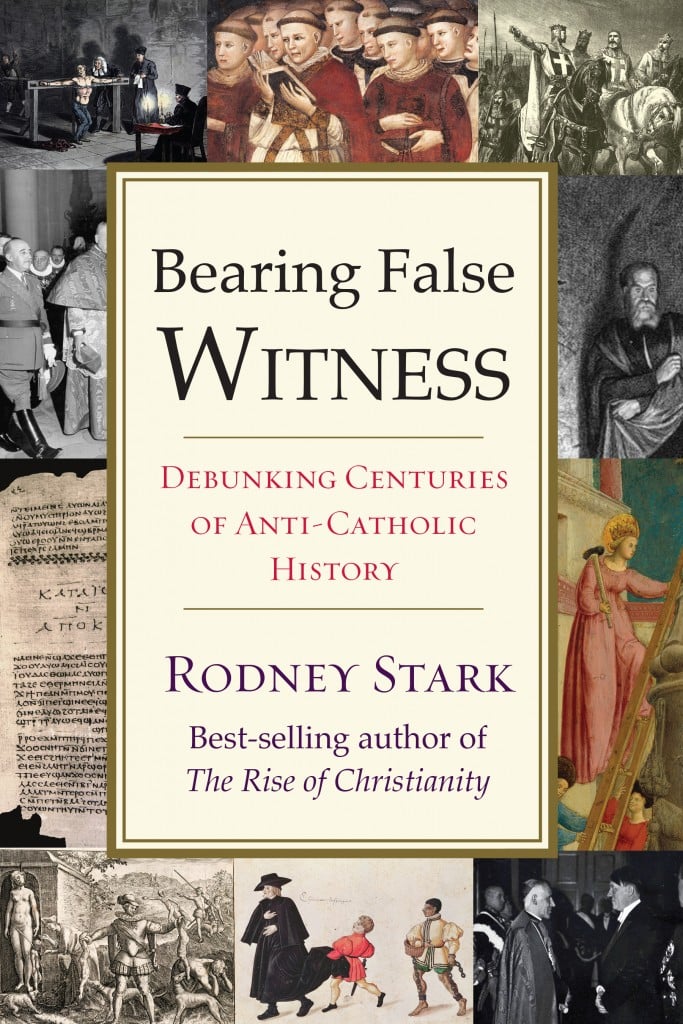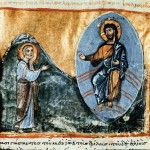
Rodney Stark’s newest book, Bearing False Witness: Debunking Centuries of Anti-Catholic History, begins with a noble and needed purpose. He proposes to set the record straight on a number of slanders against Roman Catholicism, perpetrated by various enemies of the church. In doing so he seeks to defend the Catholic church, which he is keen to emphasize he is not a part of. But he is also seeking to defend history itself, from its excesses and mischaracterizations that place ideology and bias above objectivity and truth. He wrote the book, he says in the introduction, “in defense of history” (p. 7).
This is a promising premise, because historians (and others) of various kinds have unfairly and untruthfully attacked Catholics and the Catholic church, and continue to do so. As Stark points out in his postscript, this anti-Catholic bias is supposed to have disappeared with the election of John F. Kennedy (much in the same way that racism was supposed to have disappeared with the election of Barack Obama), but of course bigotry is alive and well in many forms. A book like Stark’s, dedicated to rooting out the lies and mischaracterizations behind anti-Catholic bias, would seem to be just what was needed to further the cause of understanding and ecumenical and interfaith dialogue–not to mention helping to clean out some of the darker back rooms of history.
Unfortunately, Stark’s book does not live up to that promise. Bearing False Witness is less a defense of Catholicism, and more a sustained argument against liberalism in all its forms. Stark’s modus operandi in the book is to identify a value held by liberals, turn that value into a critique of the church (whether it is or not), construct a straw man version of that value, and attack it. This is not a work of history; it is a work of apologetics.
In his first chapter, titled The Sins of Anti-Semitism, Stark is defending Catholicism against accusations of being anti-Jewish. Already, on the second page of this chapter, Stark exploits a tension that he will use throughout the book to great effect to get out of tight spots: he dissociates what “the church” does from what ordinary Christians did. This dichotomy between official church doctrines and behavior on the ground is worth recognizing, of course, but for Stark it is a get-out-of-jail-free card. Ordinary Christians are never responsible for what the church does, and the church is never responsible for what its members do, and Stark is always left with a hero. The views and actions of the “few” who “may have gotten involved in outbursts of anti-Semitic violence” (which, in any case, Stark wants us to know was not as severe as everyone thinks) “did not have official standing and did not reflect the normal behavior of Catholic clergy toward Jews” (pp. 10-11). We should pause here to acknowledge that there is undoubtedly truth to this; an organization as large and diverse as the Roman Catholic Church is more than the individuals that make it up, and as he notes, individuals act in ways that are at variance with “official standing.” But this distinction was probably lost on those Jews experiencing violence at the hands of Catholic clergy (or, later, Protestant clergy); they were probably more immediately concerned with the reality of religiously-fueled violence being perpetrated against them. Whether that violence had “official standing” was probably quite irrelevant.
This first chapter also exposes another criticism of Stark’s work–one that has dogged him since at least the publication of his most well-known work The Rise of Christianity. This criticism is that Stark is working outside the discipline he was trained in–sociology–and therefore frequently makes mistakes when it comes to other fields of knowledge. I have defended Stark on this count; I find The Rise of Christianity a useful and provocative book for the ways it takes a novel approach to the history of Christianity by breaking down disciplinary silos. But in Bearing False Witness, this interdisciplinary weakness is profound. In chapter 1, for example, as he is describing how Christianity and Judaism diverged and formed their own identities, Stark shows no awareness whatsoever of the extensive scholarly literature on this subject. He doesn’t cite the extensive Adversus Judaeos literature from antiquity, and he doesn’t cite the many, many publications on the “parting of the ways” that have redefined the ways scholars think about this period. To do so probably would have helped his argument, but he is by all appearances unaware of its existence.
The second chapter, The Suppressed Gospels, is Stark’s take on one of the most commonly-believed conspiracy theories about the Catholic church: that it has hidden or suppressed electrifying ancient texts that shed new light on Jesus. These DaVinci-Code-fueled conspiracy theories have flourished in recent years: Jesus had a wife, the church “kicked certain books out of the bible,” the so-called “Gnostic gospels” were the true teachings of Jesus. This is all hogwash, and Stark is right to reject it. But the way Stark rejects it reveals a startling lack of familiarity with the material. Take this statement, for example. On page 43, Stark says that “Any honest reading of the primary Gnostic gospels reveals that, despite some Christian content, these are fundamentally pagan scriptures” (emphasis Stark’s). That is, they are not authentically Christian. This relates to something he wrote a few pages earlier, on page 38, where he quoted Rosemary Radford Reuther unapprovingly when she said these “Gnostic gospels” help us “glimpse a time when a great variety of Christianities” competed with each other.
Stark seems to reject this claim–that there was once a time when a great variety of Christianities competed with each other–in favor of a view of history in which Christian theological orthodoxy persisted through time despite challenges from illegitimate “pagan” intrusions. But this is simply bad history. Of course multiple varieties of Christianity existed at the same time. Of course they competed with each other. The survey course I teach on the first 600 years of Christianity is called Christianities in Antiquity; the plural is an acknowledgement of the diversity of expressions of the religion. Stark knows this, I am sure. But he wants to guard some kind of orthodox purity by saying that the so-called “Gnostic gospels” are “fundamentally pagan scriptures.” They weren’t; they were texts written by self-avowed Christians as Christian texts. Stark might not agree with the theology or Christology of those texts, but they are still Christian.
But the rest of that sentence–the one that claims that they were “fundamentally pagan scriptures–” betrays Stark’s interest in the analysis. “These are fundamentally pagan scriptures,” Stark writes, “and thus are precisely the bizarre heresies that the early church said they were!” (p. 43). Later, in his concluding section of the chapter, Stark writes that these Gnostic gospels will never be accepted as canonical “because they will bear all the disqualifying marks of their Gnostic origins, which is why Irenaeus dismissed the Gospel of Judas and others as fiction nearly two thousand years ago” (p. 51). What Stark is missing in this analysis is that people like Irenaeus were constructing orthodoxy. Orthodoxy is not an independent ontology that Irenaeus compares to Gnostic texts! Irenaeus is fabricating orthodoxy in his acceptance and rejection of texts! People like Rodney Stark think certain texts and ideas are orthodox, and others are not, because of people like Ireneaus. Using Irenaeus’ words to justify the non-orthodoxy of the “Gnostic gospels” is like the pitcher also being the umpire, and calling everything a strike.
There are other problems with this chapter. One of Stark’s arguments against the “Gnostic gospels” is that they are “forgeries,” that “they were not written when they claim to have been written or by the persons to whom they are attributed” (p. 49). But of course that same claim could be made for many texts in the New Testament, which Stark does not acknowledge. Stark consistently misspells the name of a major “Gnostic” thinker. And he seems unaware that the entire category of “Gnostic” and “Gnostic gospels” is a scholarly construct, begun with the polemics of Irenaeus and perpetuated to this day as a handy category. But no one in antiquity called themselves that; that’s just what Irenaeus called his theological enemies. Stark is carrying Irenaeus’ water rather obediently.
These first two chapters are the ones that map most fully onto my own scholarly expertise, so I have focused on them. But later chapters follow the same pattern. Stark’s argument in many of them can be summarized as “it wasn’t as bad as you think.” Chapter 4: The dark ages weren’t as bad as you think. Chapter 5: The Crusades weren’t as bad as you think. Chapter 6: The Inquisition wasn’t as bad as you think. Chapter 7: The church’s anti-science views weren’t as bad as you think. Chapter 8: Slavery wasn’t as bad as you think. Even when Stark has good points to make (“dark ages” is a misleading and unhelpful category, the Inquisition wasn’t insatiably bloodthirsty always and everywhere, and the church opposed slavery at many points), the reader finds himself disagreeing with Stark, because of the questionable assumptions and poor evidence he brings to the table. He starts most chapters by building a straw man. He presents what he imagines is commonly held knowledge, and then proceeds to poke holes in the poor scarecrow. This is a compelling literary device, since it draws the reader into Stark’s indignation. “Everyone believes that the Catholic church loves slavery!” (I’m paraphrasing). “But it turns out that the Catholic church doesn’t love slavery! This is satisfying as an organizational structure, but it leaves out and excuses many instances in which the church was complicit, was turning the other way, was not keeping its hands clean. It obscures the actions of a few rogue individuals, which Stark almost always concedes while claiming that they didn’t stand for “official” church policy. This structure makes Stark read like an apologist for colonialism, slavery, violence, and ignorance–things I doubt he would claim for himself. And ultimately this book makes Stark read like an apologist for conservatism broadly construed, since somehow, the true enemy almost always seems to turn out to be liberals. (And Voltaire…Stark hates Voltaire). Examples of questionable claims could be multiplied from later chapters–Protestantism is most properly characterized by Max Weber’s work on capitalism, witches who were actually practicing magic probably had it coming, and the church was an innocent victim of the French Revolution–but this review is already too long.
I was prepared to like this book. I have enjoyed (and frequently cited) Stark’s scholarship in the past, because I appreciate his use of sociological principles in the field of religious studies. And in this book, Stark is at his best when he is using the tools of sociology to illuminate history. But those instances are few and far between. Much of this book is instance after instance of suspect historiography, selective argumentation, and disingenuous summarization. That’s especially disappointing for a book with such a promising premise. History, especially when written by Protestant scholars and those who cast a suspicious eye on religion generally, has tended to emphasize the worst of the Catholic tradition while ignoring the best. I am in complete sympathy with Stark in his desire to eradicate the slanders of history and to write history in a way that is fair to the Catholic church and those who are a part of it. But I don’t think that is what Stark has done; he has replaced one troublesome history with another, and has found a new bogeyman for the excesses and evils of the past: liberals. In this, Stark’s history is no better than the one he seeks to correct.












